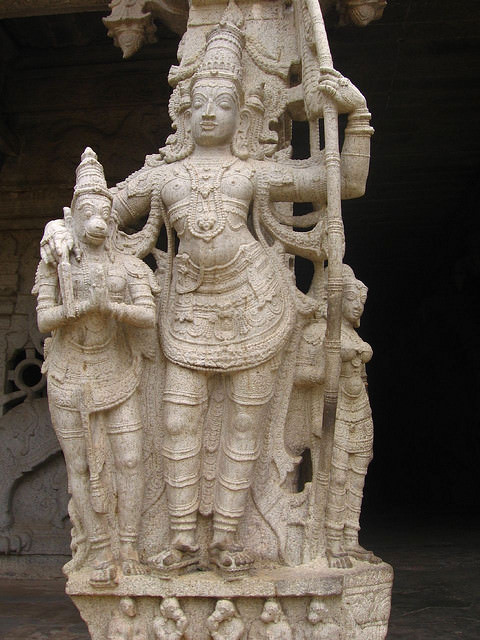Overview
Introduction to Sunderkand
Sunderkand is a significant chapter in the epic Hindu scripture, the Ramayana. It is a vivid depiction of the divine journey of Lord Hanuman to find and deliver a message to Lord Rama’s wife, Sita, who had been abducted by the demon king Ravana. This chapter is filled with devotion, bravery, and unwavering faith in the face of adversity. Lord Hanuman’s unwavering dedication to Lord Rama and his selfless actions serve as an inspiration to millions of devotees worldwide. Sunderkand showcases the power of faith and the triumph of good over evil, making it a revered and cherished part of Hindu mythology.
Significance of Sunderkand in Hinduism
Sunderkand holds immense significance in Hinduism. It is a chapter from the great Indian epic, Ramayana, and is considered as a sacred text. The word ‘Sunderkand’ translates to ‘beautiful chapter’, and it is believed to be a depiction of the divine beauty and devotion of Lord Hanuman. This chapter narrates the journey of Hanuman to Lanka in search of Sita, the wife of Lord Rama, who was abducted by the demon king, Ravana. Sunderkand is revered by millions of Hindus around the world and is often recited or listened to as a form of prayer and devotion. It serves as a source of inspiration and guidance for individuals seeking spiritual enlightenment. The recitation of Sunderkand is also available on platforms like YouTube, where people can listen to the mesmerizing verses and immerse themselves in the divine aura of this sacred text.
Summary of the Story
The Sunderkand is a chapter from the epic Ramayana, which tells the story of Lord Rama’s journey to rescue his wife Sita from the demon king Ravana. It is considered to be one of the most important chapters in the Ramayana and holds great significance for devotees of Lord Rama. The Sunderkand narrates the adventures of Hanuman, the monkey god, as he searches for Sita in the kingdom of Lanka. It showcases Hanuman’s unwavering devotion and his extraordinary powers. The chapter is filled with thrilling encounters, divine interventions, and powerful messages of faith and devotion. It serves as a source of inspiration and guidance for millions of people around the world, who find solace and strength in the divinity of Sunderkand.
Historical Background
Origins of Sunderkand
The origins of Sunderkand can be traced back to the Indian epic, Ramayana. Sunderkand is a chapter in the Ramayana that focuses on the adventures of Hanuman, the monkey god. It is considered to be one of the most important and revered chapters in the Ramayana. Sunderkand showcases the divinity and devotion of Hanuman as he embarks on a journey to find Sita, the wife of Lord Rama, who has been abducted by the demon king Ravana. This chapter highlights the unwavering loyalty and dedication of Hanuman towards Lord Rama and his determination to reunite him with his beloved wife. Sunderkand has gained significant popularity over the years and has become a subject of interest for scholars, researchers, and devotees alike. It holds a prominent place in Hindu mythology and its significance is evident in its Google ranking as one of the most searched topics related to Ramayana.
Influence of Valmiki’s Ramayana
The influence of Valmiki’s Ramayana on Hindu mythology and devotion cannot be overstated. This ancient epic, composed by the sage Valmiki, narrates the heroic journey of Lord Rama and his loyal companions, including his beloved wife Sita. The character of Sita, a symbol of purity, devotion, and strength, has captivated the hearts of millions. Her unwavering faith in Rama and her selfless sacrifice during her abduction by the demon king Ravana are central to the Ramayana’s narrative. Sita’s unwavering love and loyalty towards Rama serve as an inspiration for devotees, highlighting the importance of trust, devotion, and righteousness in one’s life. Valmiki’s Ramayana has not only shaped the cultural and religious landscape of India but has also influenced literature, art, and music across the world.
Spread of Sunderkand in India
The spread of Sunderkand in India has been remarkable. This ancient Hindu scripture, which is a part of the Indian epic Ramayana, holds immense significance for devotees across the country. Sunderkand is not just a religious text, but a source of inspiration and spiritual guidance for millions of people. It has been passed down through generations, with its teachings and stories being shared in various forms. From recitations in temples to performances in theaters, Sunderkand has found its way into the hearts of the Indian population. The popularity of Sunderkand can be attributed to the profound experiences it offers to those who engage with it. By experiencing the divine verses and narratives of Sunderkand, individuals are able to connect with their spirituality and find solace in the teachings of Lord Hanuman. The spread of Sunderkand in India is a testament to the enduring devotion and faith of the Indian people.
Divine Characters
Lord Hanuman
Lord Hanuman is a prominent figure in Hindu mythology. He is revered as the epitome of devotion and strength. In the epic Ramayana, Hanuman plays a crucial role in the search for Sita, Lord Rama’s wife, who has been abducted by the demon king Ravana. Sunderkand, a chapter in the Ramayana, focuses specifically on Hanuman’s journey to Lanka to find Sita. It is a tale of bravery, determination, and unwavering faith. Sunderkand is considered a sacred text in Hinduism and is often recited by devotees to seek Hanuman’s blessings. The word ‘Sunderkand’ translates to ‘beautiful chapter’ in Hindi, highlighting the significance and beauty of this section of the Ramayana.
Lord Rama
Lord Rama is a central figure in Hindu mythology and is considered to be the seventh avatar of Lord Vishnu. He is revered as the epitome of righteousness, courage, and devotion. Lord Rama’s story is depicted in the epic Ramayana, where he embarks on a journey to rescue his wife Sita from the demon king Ravana. Throughout the epic, Lord Rama displays unwavering faith in dharma (righteousness) and fulfills his duties as a prince, husband, and ruler. His unwavering devotion to his family, his subjects, and his divine purpose serves as an inspiration to millions of devotees across the world. Lord Rama’s teachings and actions continue to guide people in leading a righteous and meaningful life.
Goddess Sita
Goddess Sita is a central figure in the epic of Ramayana. She is known for her unwavering devotion and steadfastness towards her husband, Lord Rama. Sita is revered as the epitome of purity, virtue, and sacrifice. Her love and dedication towards Rama are unparalleled, as she willingly chose to accompany him during his exile in the forest. Despite facing numerous hardships and trials, Sita remained faithful and loyal to Rama. Her strength and resilience are evident in her unwavering faith in the face of adversity. Sita’s character serves as an inspiration to millions, highlighting the importance of love, devotion, and loyalty in relationships.
Devotional Practices

Recitation of Sunderkand
Sunderkand, an epic chapter from the Ramayana, holds immense significance in Hindu mythology. It is a recitation dedicated to Lord Hanuman, the epitome of devotion and strength. Sunderkand is widely revered and recited by millions of devotees around the world. In the state of Odisha, Sunderkand holds a special place as it is also recited in the local language, Odia. The recitation of Sunderkand in Odia adds a unique touch, allowing devotees to connect with the divine in their native tongue. The powerful verses and captivating narrative of Sunderkand continue to inspire and uplift countless individuals on their spiritual journey.
Benefits of Chanting Sunderkand
Chanting Sunderkand has numerous benefits that can positively impact one’s life. It is believed to bring peace, prosperity, and harmony to the individual. The recitation of Sunderkand helps in relieving stress and anxiety, providing a sense of calmness and tranquility. It is also said to enhance concentration and focus, making it easier to deal with daily challenges. Additionally, chanting Sunderkand is believed to purify the mind and soul, promoting spiritual growth and self-realization. The powerful verses and hymns in Sunderkand have the ability to invoke divine blessings and protection. By chanting this sacred text, one can experience a deep connection with Lord Hanuman and receive his divine grace. Overall, the practice of chanting Sunderkand offers numerous physical, mental, and spiritual benefits.
Sunderkand in Temples and Ashrams
Sunderkand in Temples and Ashrams
Symbolism and Allegory

The Journey of Hanuman
The Journey of Hanuman is a significant part of the epic Ramayana. Hanuman, the mighty monkey god, embarks on a perilous journey to find Sita, the wife of Lord Rama, who has been abducted by the demon king Ravana. Hanuman’s journey takes him through various challenges and obstacles, showcasing his immense strength, intelligence, and devotion. He crosses vast oceans, encounters powerful creatures, and faces numerous tests of his loyalty and determination. Throughout his journey, Hanuman remains steadfast in his mission, displaying unwavering faith and dedication to Lord Rama. The Journey of Hanuman is a tale of courage, resilience, and unwavering devotion that continues to inspire millions of people across different cultures and languages.
The Trials and Triumphs
The Trials and Triumphs section of the article explores the challenges and victories encountered in the epic tale of Sunderkand. Sunderkand, a significant chapter in the Ramayana, holds immense importance in Hindu mythology. It narrates the journey of Lord Hanuman to find and bring back the divine herb, Sanjeevani, to save Lord Lakshmana. This section delves into the various obstacles faced by Lord Hanuman during his mission and the ultimate triumph of good over evil. The trials faced by Lord Hanuman serve as a testament to his unwavering devotion and loyalty to Lord Rama. The story of Sunderkand is particularly revered in the Odia community, where it is widely celebrated and recited with great devotion.
Lessons for Devotees
The Sunderkand, a chapter from the Indian epic Ramayana, is a tale of heroism and devotion. It teaches valuable lessons for devotees. One of the key lessons is the importance of unwavering faith in the face of adversity. The protagonist, Hanuman, displays heroic courage and determination as he embarks on a perilous journey to find Sita, the wife of Lord Rama. His unwavering devotion to Lord Rama is highlighted throughout the chapter, serving as an inspiration for devotees. Hanuman’s actions demonstrate the power of selfless service and the rewards that come with it. The Sunderkand also emphasizes the significance of surrendering to a higher power and trusting in divine intervention. Through Hanuman’s actions, devotees learn the importance of humility and the rewards that come with surrendering to the divine will. Overall, the Sunderkand serves as a guide for devotees, teaching them the virtues of faith, courage, devotion, and surrender.
Impact on Devotees
Spiritual Transformation
Spiritual transformation is a profound journey of self-discovery and enlightenment. It is a process of awakening the inner divinity and cultivating a deep sense of devotion. In the context of Sunderkand, a chapter from the epic Ramayana, spiritual transformation takes on a whole new meaning. Sunderkand narrates the heroic journey of Lord Hanuman to find and deliver a message to Lord Rama’s wife, Sita, who has been abducted by the demon king Ravana. Through his unwavering faith, courage, and determination, Hanuman undergoes a spiritual transformation that transcends his physical limitations and connects him with the divine. This transformation is a testament to the power of devotion and the infinite possibilities that lie within each individual.
Healing and Protection
In the epic of Ramayana, Sunderkand is a significant chapter that holds immense importance for devotees. It is believed to be a source of healing and protection. Sunderkand is a powerful prayer that is recited to seek blessings from Lord Hanuman, the epitome of devotion and strength. This chapter narrates the journey of Hanuman to Lanka in search of Sita, Lord Ram’s wife, who was abducted by the demon king Ravana. Sunderkand showcases the unwavering faith and determination of Hanuman as he overcomes various obstacles and challenges. It serves as a reminder of the divine power and the ability to overcome adversity. The recitation of Sunderkand is considered to bring peace, prosperity, and protection to the devotees. It is often recited in times of distress and is believed to provide solace and relief. The rich verses of Sunderkand are filled with profound wisdom and teachings, making it a treasure trove of spiritual knowledge.
Inspiration and Guidance
The Sunderkand is a chapter in the Hindu epic Ramayana that focuses on the adventures of Lord Hanuman. It is considered to be a sacred text and is recited by devotees to seek inspiration and guidance. The chapter narrates the journey of Hanuman to find and rescue Sita, the wife of Lord Rama, who has been abducted by the demon king Ravana. The Sunderkand is filled with profound teachings about devotion, courage, and loyalty. It serves as a source of inspiration for millions of people around the world, reminding them of the power of faith and the importance of staying true to one’s values.
Author Profile

Latest entries
- 28 June 2025BlogHow to Choose the Best High-Yield Savings Account with 5%+ Interest in India (2025 Guide)
- 28 December 2024Blog13 High CPC Blog Niche for 2025
- 28 December 2024BlogTop 6 Employee Management Software for Small Businesses
- 19 December 2024BlogShri Hanuman Chalisa in Hindi Text with English Translation

